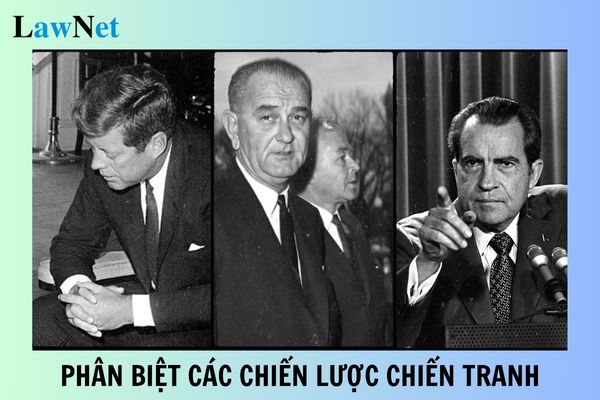Distinction among strategies of Special Warfare, Joint Warfare, Vietnamization in the Vietnam War
Distinction among strategies of Special Warfarefare, Joint Warfare, Vietnamization in the Vietnam War
The Special Warfare, Joint Warfare, Vietnamization strategies are implemented by the U.S. in Vietnam exhibit fundamental differences as follows:
Regarding Time and Circumstances
- Special Warfare: From 1961 to 1965, after the failure of ruling by the puppet dictatorial government of Ngo Dinh Diem, the U.S. was compelled to transition to the Special Warfare Strategy.
- Joint Warfare: Conducted from 1965 to 1968. Following the failure of the "Special Warfare," the U.S. intensified the conflict, transitioning to the "Joint Warfare" strategy.
- Vietnamization: Occurred from 1969 to 1973. The U.S. continued the colonial war of invasion in South Vietnam, shifting to the "Vietnamization" strategy and expanding the war across Indochina with the "Indochinaization" strategy.
Regarding Area of Execution
- Special Warfare: South Vietnam.
- Joint Warfare: Stabilizing South Vietnam while expanding destructive warfare to the North.
- Vietnamization: Extend the war across the entire Vietnam region and into the entire Indochina area.
Regarding Forces Involved
- Special Warfare: Saigon puppet army.
- Joint Warfare: U.S. and allied expeditionary forces.
- Vietnamization: Saigon puppet troops, with U.S. forces gradually withdrawing.
Regarding Basic Tactics
- Special Warfare:
+ Proposed the Stanley-Taylor plan to pacify South Vietnam within 18 months.
+ Increased military aid to Diem, established "strategic hamlets," employed new tactics such as "helicopter transport" and "armored personnel carriers."
- Joint Warfare:
+ Launched the "Search and Destroy" operation targeting the Liberation Army base in Van Tuong.
+ Conducted two consecutive dry-season strategic counteroffensives.
- Vietnamization:
+ U.S. and allied forces gradually withdrew to reduce American casualties on the battlefield, simultaneously increasing the Saigon army's strength, with the intention of using Vietnamese to govern Vietnamese and using Indochinese to fight Indochinese.
+ Employed tactics such as exploiting Sino-Soviet relations, compromising with China, and easing tensions with the Soviet Union to limit these countries' support for our people's resistance.
Regarding Our Military's Important Victories
- Special Warfare: Ap Bac victory in 1963.
- Joint Warfare: The Tet Mau Than Offensive and Uprising in 1968.
- Vietnamization: Counteroffensive Campaign on Route 9 - Southern Laos and the 1975 Spring Offensive and Uprising.
Significance of Our Victories
- Special Warfare: Forced the U.S. to transition to a Joint Warfare.
- Joint Warfare: Forced the U.S. to declare "de-Americanization" and sit at the negotiation table with us in Paris.
- Vietnamization: Forced the U.S. to sign the Paris Agreement.
Note: Content is for reference only!

Distinction among strategies of Special Warfare, Joint Warfare, Vietnamization in the Vietnam War (Image from Internet)
What are requirements for the content of the Resistance Against the American Invasion included in grade 12 curriculum in Vietnam?
Based on the History Education Program for Upper Secondary Level issued with Circular 32/2018/TT/BGDDT, the following requirements must be met for the content of the resistance against the American invasion included in grade 12 curriculum:
- Know how to collect and use historical materials to learn about the resistance against the American invasion.
- Present a general overview of the historical context and main stages of development of the resistance against the American invasion.
- State the reasons for victory in the resistance against the American invasion.
- Analyze the position and historical significance of the resistance against the American invasion in the course of Vietnam's history.
- Respect and pride in the indomitable tradition of our ancestors during the resistance against the American invasion, and participate in the gratitude activities at the local level.
What are methods for forming and developing common capabilities in History subject in Vietnam?
According to the History Education Program for Upper Secondary Level issued with Circular 32/2018/TT/BGDDT, the methods for forming and developing common capabilities in History subject include:
- Self-reliance and self-learning ability: formed and developed through learning activities such as collecting information from historical sources; presenting personal opinions about events, characters, historical processes; surveying, practicing history on-site, historical and cultural monuments at the local level; applying historical knowledge to explain real-world issues; exploring and self-learning history.
- Communication and collaboration ability: formed and developed through group activities; experiential activities at on-site locations, museums, historical and cultural monuments; activities interviewing historical witnesses.
- Problem-solving and creativity ability: formed and developed through activities identifying problems, formulating hypotheses, personal opinions about historical events and characters; finding logic in problem-solving methods, evaluating solutions to historical problems; applying historical lessons in real life.

